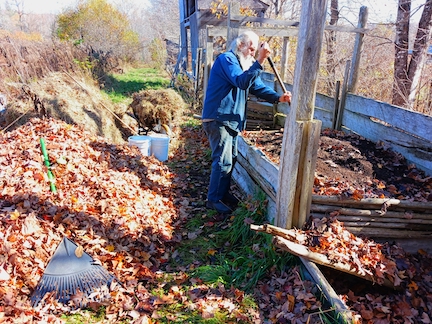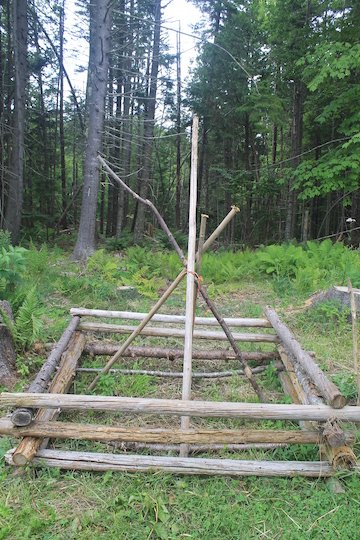By Will Bonsall
Suppose you want to improve your garden soil’s tilth by organic means, but for some reason or other animal manure just doesn’t work for you. Maybe you just don’t have access to it since you don’t keep livestock yourself. Maybe you can buy commercial compost mixes (which are largely cow manure), but they’re too pricey. Maybe you live in a suburban area where neighbors will object to the smell. Of course, if you’re vegan the use of any animal inputs will be problematic, but I’m assuming you have no ideological qualms, but merely pragmatic concerns such as those mentioned above.
Here’s one example: Years ago, two women from Portland, Maine, (public works, I believe) attended one of my farm tours, and the composting system was their main focus. They pointed out that the municipal waste stream of most cities like Portland consisted of 40% yard waste: mostly grass clippings, tree leaves, chipped wood (from landscapers) and smaller amounts of kitchen refuse. As I understood it, they were not so much looking to do a municipal composting system (which they may have already had, this was many years ago), but rather to initiate a program encouraging homeowners to process their own compostable materials. Although most residents in downtown areas might not have space for a composting system (set of bins), these residents weren’t the main source of the yard waste. Rather, it was coming from the outlying residential neighborhoods where folks actually had lawns and shade trees — and also the space to handle the materials generated. Mind you, the composting idea was not rooted in the assumption that Portland residents had gardens; the main objective was to keep bulky materials out of the landfill regardless of what became of the end results. In fact, the women pointed out that even if the compost ended up in the landfill (!?) it would nevertheless be reduced in volume by at least 50%. Of course, you and I know that’s a foolish idea, but I found it intriguing that our extremely different perspectives led us to the same implications. The very ingredients I use for soil building on the farm, those which the land itself produces, are the same as the waste products of Portlanders’ yards.
There’s one big difference though: They may view composting as a means of waste disposal, preventing leaves from blowing into the swimming pool and keeping the grass short under the volleyball net, whereas for me it is a desired product — a crop, a resource that I can parlay into the food on my plate. As I remember, my visitors explained that whatever compost the townsfolk didn’t want could be used by the city on public spaces (like Deering Oaks I suppose). Absurd, I feel, but admittedly better than clogging the landfill.
Assuming homeowners are convinced to compost their own yard waste, then how to teach them how to do it? After all, it’s not quite as simple as piling a bunch of trash and garbage. Improperly made compost heaps can attract rodents and flies, and smell foul, while yielding an inferior product. And that is why those two women had traipsed all the way up to Industry, Maine, to see how I do it.
A thing we had in common is that our ingredients were in comparable proportions: lots of leaves, plenty of grass and moderate amounts of kitchen waste. That was not a planned strategy, it’s just what you naturally get when you use the stuff which the land itself produces, without bringing in a lot of “outside material” in what I call “cake-mix gardening.” The difference in our scales (homestead vs. municipal) required some different approaches. For example, I’m making compost throughout the snow-free year. Obviously I only have grass when it’s green to mow, most of my leaves are available in October, and my kitchen is generating scraps year-round (though especially in late fall when I’m processing food or cleaning up crop residues). I wish to have some consistency and continuity in my piles for the sake of a roughly uniform product. Insofar as possible I achieve this by stockpiling: I have a large holding bin where I collect all the leaves for the whole year. I prefer to store the shredded leaves — what I call “confetti” — in a screened shed for use as either mulch or compost, but as I always have more than I have time to shred, I simply gather those into a large corral of posts and hex-wire, to be shredded on demand or used whole. The leaves in the shed stay dry, those in the corral get soaked by springtime (even if tarp-covered, the pile wicks moisture up from the ground over winter). For mulch, the confetti is much preferred; for compost, I can use either, though even a course shredding is very desirable. Lacking a chipper or shredder, a walking mower will do an adequate job of shredding for compost.
As for grass, mine is somewhere between lawn clippings and hay, much like what’s called “greenchop.” As such, I usually allow it to dry somewhat before raking and hauling. Stacked in high mounds it remains reasonably dry until I’m ready to assemble the compost pile. Otherwise, it will become all hot and moldy before I’m ready to assemble the other ingredients. True, I’m just going to let it all rot anyway, but I don’t wish for all that nitrogen and heat generation to be exhausted before the pile is assembled so I can achieve a balance with the colder high-carbon materials like leaves. This is where the municipal system runs into trouble, as the grass coming in is already heating up regardless of whether other ingredients are ready yet. That’s why having a stockpile of shredded leaves is very helpful.

What about kitchen waste? It’s a relatively small part of the waste stream (both mine and Portland’s), yet very rich and prone to attract pests and foul odors. If I’m incorporating it directly into the pile, no problem, but what about the garbage I’m generating in the winter? In my own case, I simply stockpile it in five-gallon plastic buckets with tight lids. On a municipal scale that’s not quite so simple, but, hey, it works for me. I should add that the urban waste stream is not completely vegan, due to meat scraps, bones and eggshells. The same is true of your own wastes if you are not vegan. Even if you have no scruples about that and animal-derived scraps are a miniscule part of the whole, they will attract rodents, skunks, racoons, neighbors’ dogs, etc. Better cull them out beforehand.
Another problem confronting the home composter is batch size. A pile that is too small, or built over too long a timespan, will not heat up properly. So why is that important? It is the aerobic heat of the compost pile that will kill weed seeds, destroy bug eggs, sterilize disease spores, and commence the breakdown of tough fibrous materials. A pile of less than 4 feet in every direction may not generate the critical mass heat for this to occur. Moreover, the pile should be contained within a fairly compact mass rather than spread out on the ground.

Composters find innovative ways to create structures with what’s available. My dad used to wire four wooden pallets together, easily dismantled for turning (which should be done at least twice in the overall process). Helen and Scott Nearing used horizontal poles crisscrossed at the corners. I have a more permanent system of five tandem bins with 5-by-5-inch squared cedar posts set deeply in the ground (scorched below ground to prevent rot), with planks or poles fastened to them, all removeable for filling, turning or emptying.
Some useful details: As I build each pile, I alternate layers (dry with wet, high-nitrogen with high-carbon, organic with mineral/dirt) until the bin is about 6 feet high. Then I water the whole pile with 50 to 100 gallons of water depending on wetness of ingredients. The pile should heat up to 160 degrees Fahrenheit within 72 hours and will have cooled off in about three weeks. At that time, I fork it all into the adjacent bin, where it should heat up again though not as much. The contents will have settled down to at least 50% of the initial volume. In my 5-by-8-foot bins, each bin will contain one ton for every foot of depth (after the first turning), since compost weighs about 50 pounds per cubic foot. A bin can be finished and ready to apply within three months.
There are a number of soil and plant diseases that I don’t seem to have any trouble with (although I’m no expert on this). I attribute at least some of that to the absence of animal manure in my crop system.
Incidentally, I also use my own humanure (read “Humanure: It’s Not a Four-Letter Word” on mofga.org), but I compost that separately for various reasons.
About the author: Will Bonsall lives in Industry, Maine, where he directs Scatterseed Project, a seed-saving enterprise. He is the author of “Will Bonsall’s Essential Guide to Radical Self-Reliant Gardening” (Chelsea Green, 2015). And indeed, he is also a distant cousin of another exemplary Maine horticulturist: Tom Vigue. You can contact Will at [email protected].
This article was originally published in the winter 2022-23 issue of The Maine Organic Farmer & Gardener.
